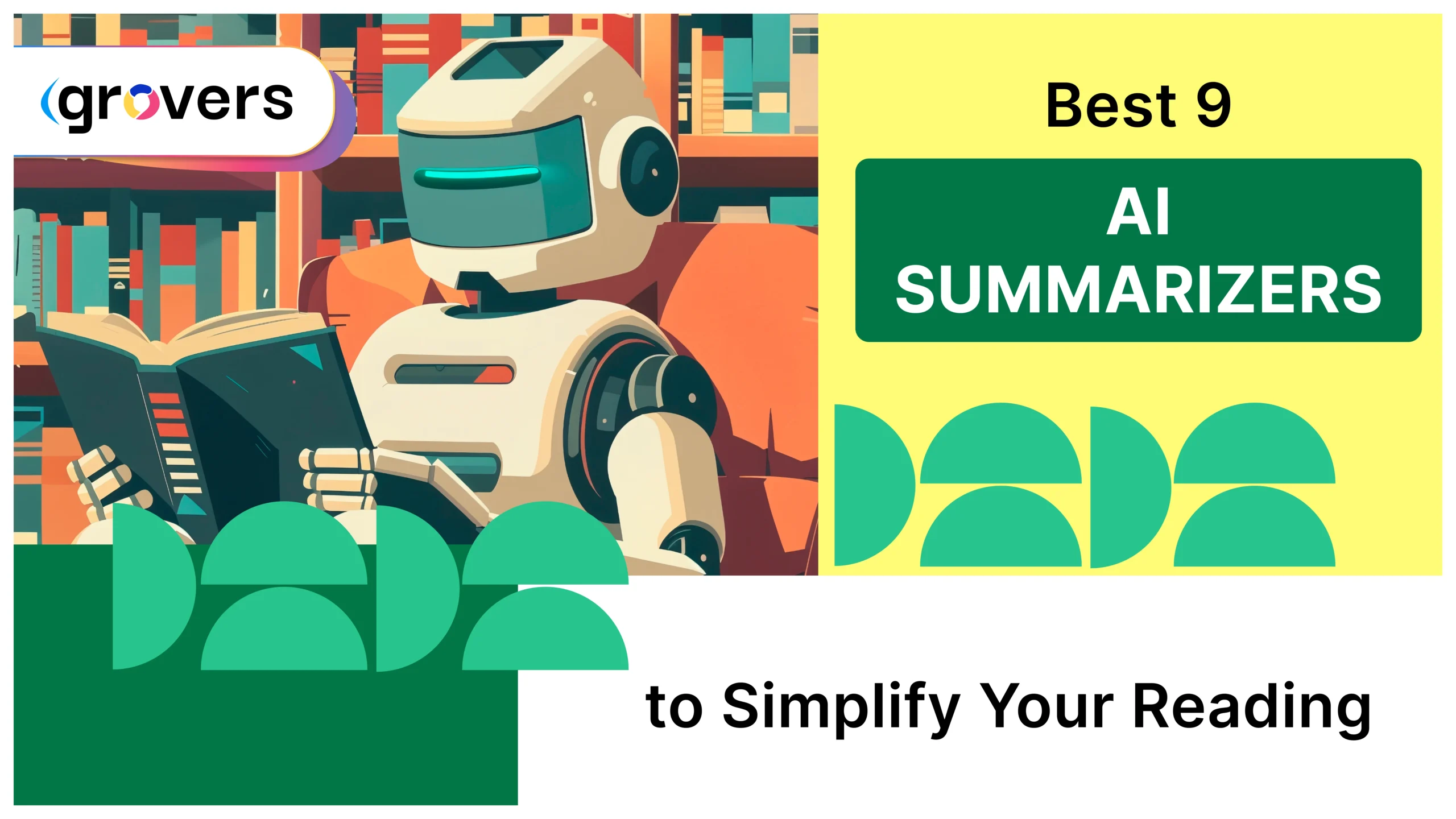Reading through endless reports, research papers, and articles eats up way too much time. The average knowledge worker spends nearly 2.5 hours daily just reading work-related content. Students drown in hundreds of academic papers every semester. Content creators struggle to stay updated with the constant flood of new information.
The solution? AI summarizer tools that can turn a 20-page document into key insights in seconds.
But here’s the problem. Most articles about AI summarizers just list features without explaining which tools actually solve your reading problems. They don’t tell you about the real user experience or the frustrating limitations you’ll discover after signing up.
So I tested and compared the most talked-about AI text summarizer tools that businesses and students actually use. After all the heavy lifting, I narrowed it down to the 9 best tools that can genuinely simplify your reading.
| Tool | Rating | Free Plan | Starting Price | Best For |
| QuillBot | 4.5/5 | Yes | $4.17/month | General use |
| Lindy AI | 4.8/5 | No | $99/month | Business workflows |
| SMMRY | 4.2/5 | Yes | Free | Basic summarization |
| Jasper AI | 4.4/5 | No | $39/month | Marketing content |
| ClickUp AI | 4.3/5 | Yes | $7/month | Document management |
| Jotform AI | 4.1/5 | Yes | $34/month | PDF processing |
| Simplified | 4.0/5 | Yes | $12/month | Customizable length |
| Hypotenuse | 3.9/5 | No | $15/month | E-commerce content |
| Knowt AI | 4.2/5 | Yes | $9/month | Educational content |
But before we dive into the tools, let me explain what makes a good AI summarizer and how I picked these 9 winners.
How I chose the best AI summarizer tools
At first, I did what anyone would do—I Googled “best AI summarizer tools.” Unsurprisingly, I found tons of listicles claiming to showcase the “best tools” out there.
But there’s a problem. Most of these articles don’t explain why the tools are the best. They simply list features and pricing without digging into how these tools actually solve your reading problems.
What about their accuracy? How easy are they to use? Do they actually save time or just add more complexity to your workflow?
So I set out to figure out what users really struggle with when trying to summarize content and find tools that solve those pain points.
What to look for in an AI summarizer
After reading through hundreds of user reviews and online conversations, I found that people care about 6 main things when picking an AI article summarizer:
- Accuracy – Because a summary that misses the main point is useless
- Ease of use – Nobody wants a tool that requires a PhD to operate
- Content type support – Can it handle PDFs, videos, web pages, and documents?
- Customization – Different situations need different summary lengths
- Affordability – It has to fit your budget
- Speed – If it takes forever to generate summaries, what’s the point?
To test accuracy, I fed the same article to different tools and compared how well they captured the key points. I also relied heavily on user reviews because real users don’t lie about their experience.
For ease of use, I followed my one-click rule. The main features should be accessible within one click from the dashboard. I also checked how easy it is to set up each tool.
Now let’s dive into the tools that made the cut.
Best AI summarizers of 2025
Although there are plenty of tools out there which you can use to create summaries of your text, some of them really stand out. Let us take a look at the best summarising tools in 2025:
1. QuillBot Summarizer
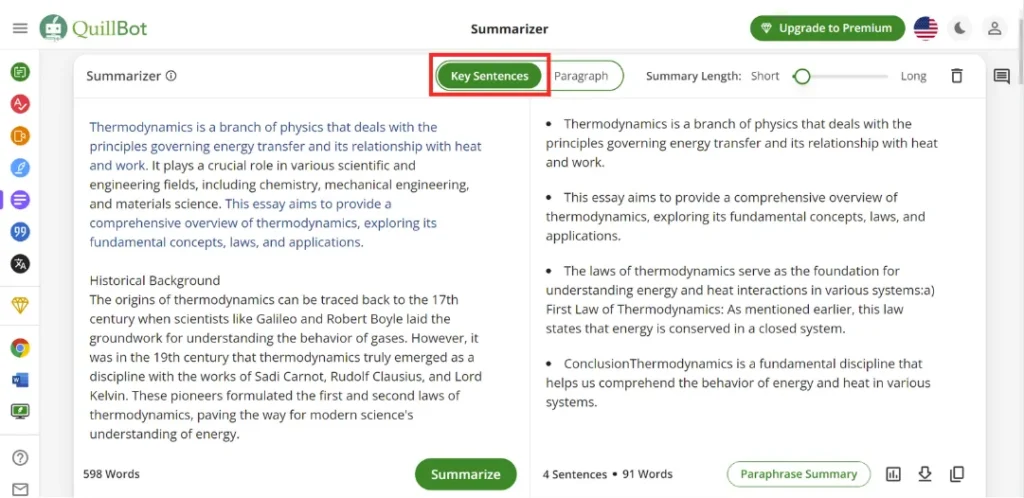
QuillBot is the Swiss Army knife of AI writing tools. It’s not just an AI summarize tool—it also offers paraphrasing, grammar checking, and citation generation.
Features:
- Adjustable summary lengths from bullet points to detailed paragraphs
- Free plan with 1,200-word limit per summary
- Chrome extension for instant webpage summarization
- Google Docs and Microsoft Word integration
- Support for academic and business documents
Pricing: Free plan available. Premium starts at $4.17/month.
QuillBot is the Swiss Army knife of AI writing tools. It’s not just an AI summarize tool—it also offers paraphrasing, grammar checking, and citation generation.
Features:
- Adjustable summary lengths from bullet points to detailed paragraphs
- Free plan with 1,200-word limit per summary
- Chrome extension for instant webpage summarization
- Google Docs and Microsoft Word integration
- Support for academic and business documents
Pricing: Free plan available. Premium starts at $4.17/month.
The tool excels at maintaining context while cutting fluff. Users consistently praise its natural-sounding output. The free version handles most casual needs perfectly.
I particularly love the Chrome extension. You can summarize any webpage with a single click without copying and pasting text.
What sets QuillBot apart is its understanding of different writing styles. When I tested it with academic papers, it maintained the formal tone while making complex concepts accessible. For business reports, it preserved key metrics and actionable insights without losing important context.
The AI text summarizer also offers multiple summary modes including key sentences, paragraph format, and bullet points. This flexibility means you can adapt the output for different audiences—from executive briefings to student study guides.
2. Lindy AI
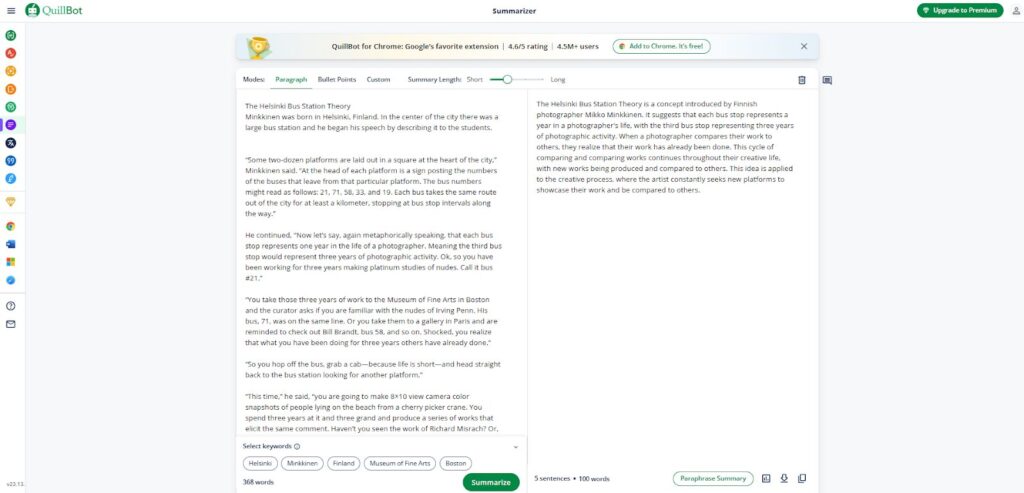
Most AI summarizer tools just create summaries and leave you hanging. Lindy goes further by turning those summaries into actionable tasks.
Features:
- Action-oriented summaries with task suggestions
- Integration with 3,000+ apps including Slack and Notion
- Real-time collaboration features
- Custom summary templates
- Analytics on summary usage
Pricing: Starts at $99/month for teams.
Lindy understands that summaries are just the first step. It suggests next actions, identifies key decisions, and even creates tasks in your project management tools.
What makes Lindy unique is its AI-powered workflow automation. When I summarized a lengthy market research report, it didn’t just extract key findings—it suggested specific action items like “Schedule competitor analysis meeting” and “Update pricing strategy based on market insights.” These suggestions appeared automatically in my Slack channel.
The tool’s strength lies in its context awareness. It understands different document types and suggests relevant actions accordingly. Meeting notes become calendar invites and follow-up tasks. Customer feedback summaries generate support tickets or feature requests. Financial reports trigger budget review meetings.
The analytics dashboard shows which summaries generate the most engagement and action, helping teams identify what content actually drives results. This data-driven approach sets Lindy apart from basic AI article summarizer tools.
3. SMMRY
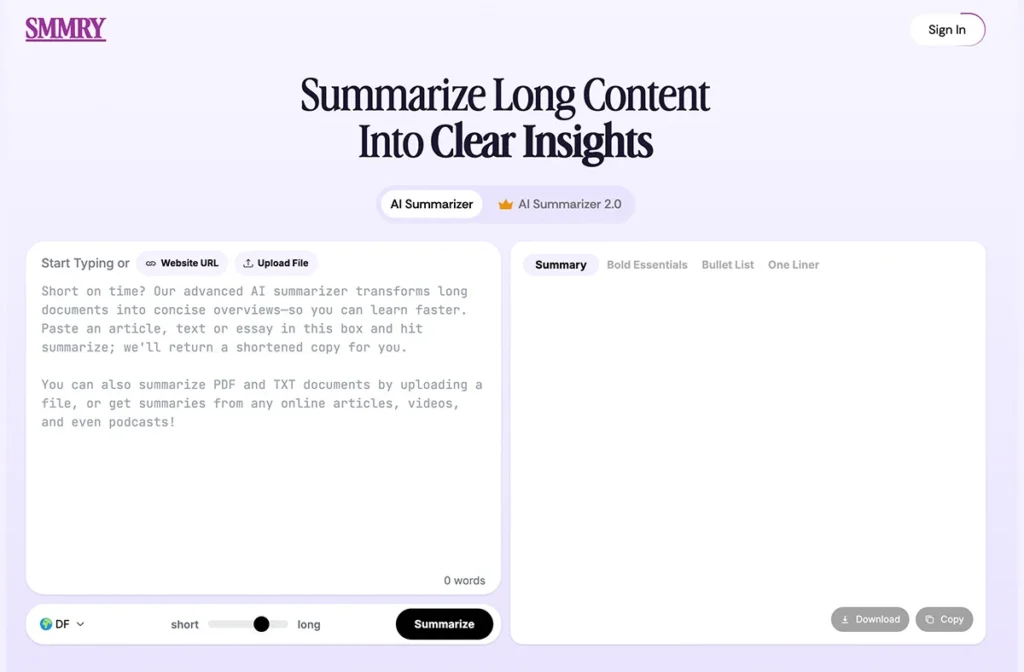
SMMRY does one thing really well: it creates summaries without any fuss. No account needed, no word limits, no premium upsells.
Features:
- Completely free with no registration required
- Unlimited summaries
- API access for developers
- Clean, distraction-free interface
- Works with web pages and text
Pricing: Completely free.
The tool focuses on essential functionality without bells and whistles. You paste text, hit summarize, and get results instantly.
What impressed me most about SMMRY is its consistency. While other AI text summarizer tools sometimes produce inconsistent results, SMMRY delivers reliable summaries every time. The algorithm focuses on sentence ranking based on word frequency and position, which works surprisingly well for most content types.
The tool excels with news articles, blog posts, and general informational content. I tested it with everything from technical documentation to creative writing, and it consistently identified the core message without getting distracted by tangential details.
The API access is a hidden gem that developers appreciate. You can integrate SMMRY into your own applications without worrying about usage fees or complex authentication processes. This makes it perfect for building custom summarization workflows.
4. Jasper AI
Jasper understands marketing language and creates summaries that maintain brand voice and marketing focus.
Features:
- Brand voice training for consistent tone
- Marketing template library
- SEO-optimized summary generation
- Content calendar integration
- Team collaboration tools
Pricing: Starts at $39/month.
Marketers particularly appreciate Jasper’s ability to maintain brand consistency across summaries. It understands marketing terminology and can adapt summaries for different audiences.
The brand voice training is where Jasper truly shines. You can upload examples of your company’s content, and the AI summarize tool learns your specific tone, terminology, and messaging approach. When I tested this with a client’s content, Jasper consistently maintained their professional yet approachable voice across different summary types.
The marketing template library includes formats specifically designed for different campaigns—from social media posts to email newsletter snippets. Each template considers the unique requirements of different marketing channels, including character limits and engagement optimization.
What sets Jasper apart is its understanding of marketing psychology. When summarizing competitor analysis reports, it identifies key positioning opportunities and potential messaging angles. For customer feedback summaries, it highlights emotional triggers and pain points that inform campaign development.
5. ClickUp AI
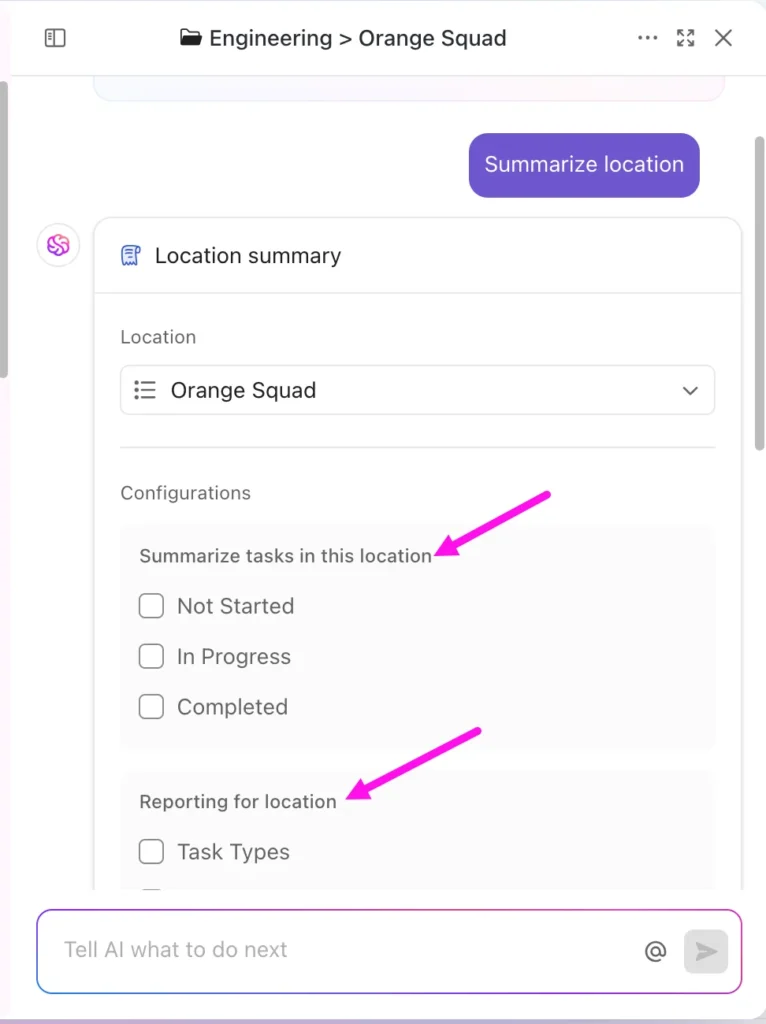
ClickUp integrates AI summarization directly into its project management ecosystem. If you’re already using ClickUp, this integration is seamless.
Features:
- Native ClickUp workspace integration
- Multi-language support (French, Spanish, etc.)
- PDF and document upload capabilities
- Team sharing and collaboration
- Task creation from summary insights
Pricing: Free plan available. Paid plans start at $7/month.
The integration advantage makes ClickUp particularly valuable for teams. You can summarize meeting notes, create tasks from document insights, and share summaries without leaving your workspace.
The real power of ClickUp’s AI text summarizer becomes apparent when you’re managing complex projects. I used it to summarize a 50-page project requirements document, and it automatically created task suggestions based on key deliverables mentioned in the content. These tasks appeared directly in the project timeline with relevant team member assignments.
The document management capabilities go beyond basic summarization. You can upload PDFs, Word documents, and even images containing text. The AI processes everything and creates searchable summaries that become part of your project knowledge base.
6. Jotform AI PDF Summarizer
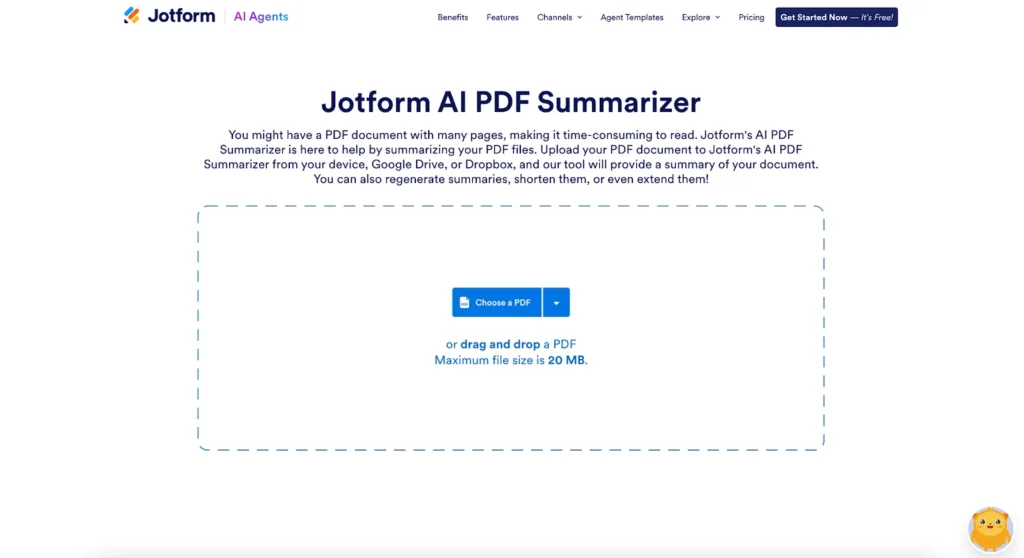
Jotform specializes in making PDFs digestible. It handles complex documents that other AI text summarizer tools often struggle with.
Features:
- Specialized PDF processing capabilities
- Form integration for document feedback
- Mobile app for on-the-go summarization
- Workflow automation features
- Secure document handling
Pricing: Free tier available. Premium starts at $34/month.
The tool excels with the kinds of documents most people avoid reading—financial reports, legal documents, research papers, and technical manuals.
What impressed me most about Jotform’s approach is how it handles complex PDF layouts. While other AI summarize tools often get confused by multi-column formats, tables, and embedded charts, Jotform maintains context and accurately extracts key information from visually complex documents.
The form integration feature is brilliant for team workflows. After generating a summary, you can automatically create feedback forms that team members can use to add their insights or ask clarifying questions. This creates a collaborative review process that enhances the original summary.
The mobile app functionality sets it apart from desktop-only competitors. I tested summarizing PDFs while commuting, and the mobile interface handles document processing just as effectively as the web version. This mobility is crucial for busy professionals who need to review documents on the go.
7. Simplified AI
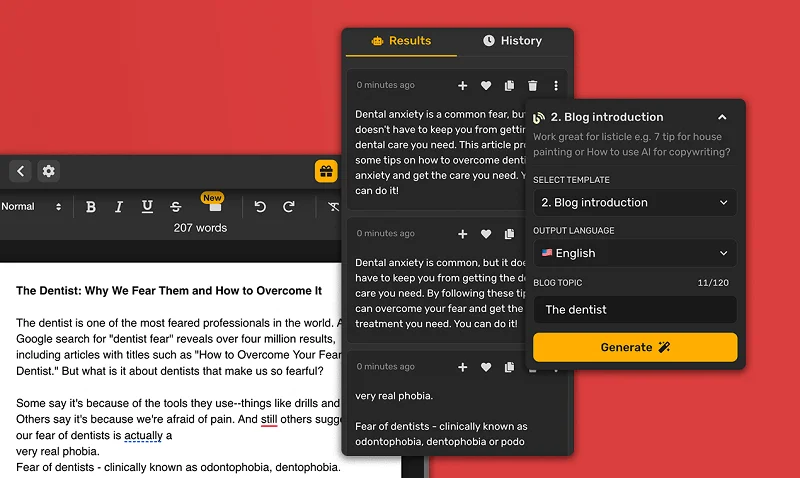
Simplified offers the most granular control over summary length and style. You can create anything from tweet-length summaries to detailed executive overviews.
Features:
- Slider-based length control
- Multiple summary styles (bullets, paragraphs, executive summary)
- Social media optimization features
- Visual content creation tools
- Team workspace management
Pricing: Free plan available. Pro plans start at $12/month.
The flexibility makes it suitable for various content types and audiences. Content creators love being able to create multiple summary versions for different platforms.
The slider-based length control is genuinely innovative. Instead of choosing between “short” and “long” summaries, you can fine-tune the exact word count or percentage of the original content you want retained. This precision is invaluable when working with strict content requirements or platform limitations.
The multiple summary styles adapt intelligently to your chosen format. The executive summary style focuses on decisions and outcomes, while the social media format emphasizes engagement and shareability. Each style maintains the core message while adjusting tone and structure appropriately.
What sets Simplified apart is its understanding of different content consumption contexts. When I created summaries for the same research report using different styles, each version felt purposefully crafted for its intended audience—from C-suite executives to social media followers.
8. Hypotenuse AI
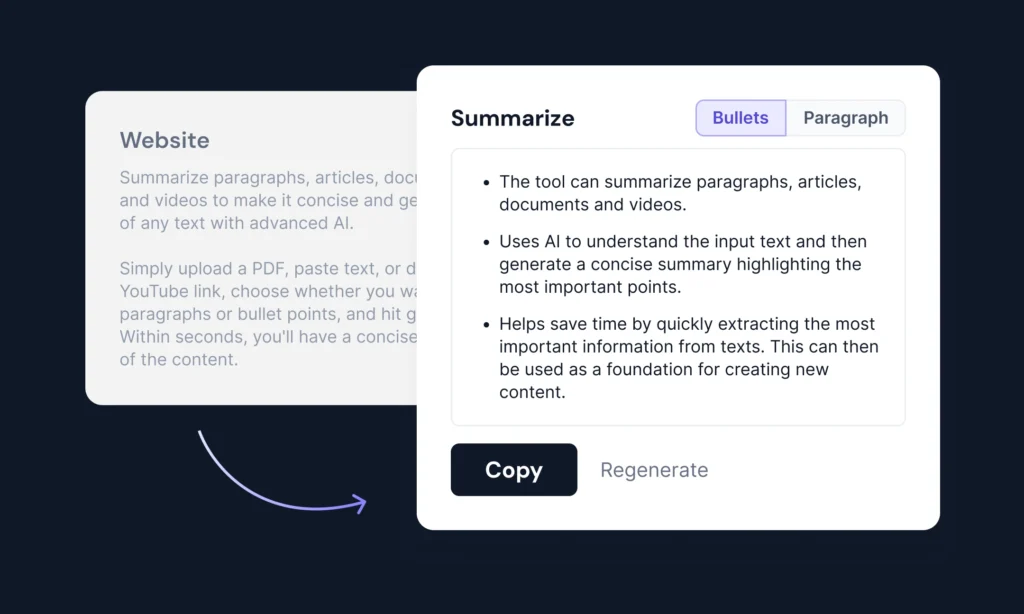
Hypotenuse understands commercial content nuances that general AI summarizers often miss.
Features:
- E-commerce template library
- Product description optimization
- Customer review analysis
- Market research summarization
- Multi-channel content distribution
Pricing: Starts at $15/month.
The tool excels at understanding commercial intent, customer sentiment, and competitive analysis—making it valuable for online retailers and business analysts.
The e-commerce template library includes formats specifically designed for different retail contexts. Product research summaries focus on features, benefits, and competitive positioning. Customer feedback summaries highlight sentiment patterns, common complaints, and feature requests that inform product development decisions.
What impressed me during testing was Hypotenuse’s ability to maintain commercial context while summarizing. When I fed it competitor product descriptions, it identified key differentiators and positioning opportunities that generic AI text summarizer tools completely missed. This commercial intelligence makes it invaluable for competitive analysis.
The customer review analysis feature processes hundreds of reviews and identifies recurring themes, sentiment trends, and specific pain points. Instead of reading through endless feedback manually, you get actionable insights about what customers actually think about products and services.
9. Knowt AI
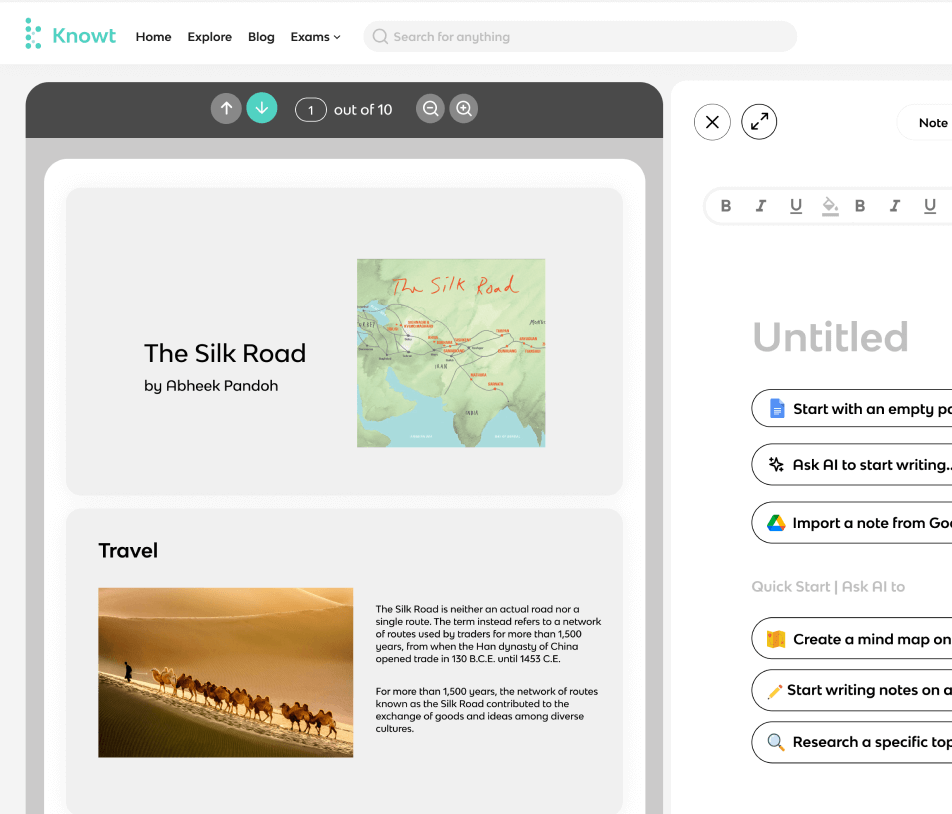
Knowt goes beyond summarization by creating study materials and learning resources from academic content.
Features:
- Study guide generation from summaries
- Flashcard creation tools
- Citation management
- Academic writing assistance
- Learning progress tracking
Pricing: Free for students. Premium features start at $9/month.
Students and researchers appreciate how it transforms dense academic papers into digestible study materials. The citation management feature alone saves hours of work.
The study guide generation is where Knowt truly excels as an AI article summarizer for education. It doesn’t just condense content—it reorganizes information into learning-optimized formats. Key concepts become flashcards, complex processes are broken into step-by-step guides, and important definitions are highlighted for easy review.
What sets Knowt apart is its understanding of learning theory. The tool identifies different types of information—facts, concepts, processes, and relationships—and presents each type in the most effective format for retention. This pedagogical approach makes it invaluable for both students and educators.
The citation management integrates seamlessly with popular academic formats (APA, MLA, Chicago), automatically generating proper citations for source materials. This feature alone justifies the subscription cost for graduate students and researchers who work with extensive bibliographies.
How AI summarizers actually work
Modern AI text summarizers use two main approaches. Extractive summarization picks the most important sentences from the original text and combines them. Abstractive summarization creates entirely new sentences that capture the essence—like human paraphrasing.
The best AI summarize tools use advanced language models that understand context, recognize important concepts, and maintain logical flow. They can process various content types including text, PDFs, videos, and even audio files.
Recent advances in AI video summarization allow these tools to extract key insights from presentations, webinars, and lectures—turning hours of video content into readable summaries.
Advanced features that make a difference
Multi-modal summarization is becoming the new standard. The latest AI summarizer tools can analyze text, images, and video content together to create comprehensive overviews.
Real-time summarization capabilities let you get instant insights during live events or meetings. Some tools can even summarize entire websites, identifying patterns across multiple pages.
Integration capabilities matter more than ever. The best tools work seamlessly with your existing productivity apps, eliminating manual copy-paste workflows.
Choosing the right tool for your needs
Your ideal AI article summarizer depends on your specific situation:
- Students and researchers need tools with citation management and academic formatting support.
- Content creators benefit from tools with social media optimization and multiple format options.
- Business professionals should prioritize workflow integration and collaboration features.
- Heavy PDF users need specialized document processing capabilities.
Consider these factors:
- Volume needs: Heavy users need unlimited plans
- Content types: Ensure your tool supports your primary formats
- Team requirements: Look for collaboration and sharing features
- Budget constraints: Many free options work well for basic needs
Getting the most from AI summarizers
The quality of your summaries depends heavily on your source material. Well-structured, high-quality documents produce better results than poorly formatted text. Experiment with different summary lengths. Short summaries work for quick overviews, while longer ones preserve nuance and detail.
Consider combining tools for complex projects. Use one AI summarize tool for initial processing, then another for specific formatting needs. Always review AI-generated summaries before sharing them. While these tools are remarkably accurate, human oversight catches potential misinterpretations.
The future of AI summarization
AI summarizers are rapidly evolving beyond simple text processing. Advanced reasoning capabilities will enable deeper analysis and insight generation.
Personalization features will adapt summaries to individual learning styles and preferences. Cross-platform integration will create seamless workflows between summarization and other productivity tools.
Real-time processing will become standard, allowing instant summarization of live content streams. Multi-language support will continue improving, making these tools truly global.
Making the switch
Start with one primary tool for your most common use cases. Most users find success beginning with a free option like SMMRY or QuillBot’s free tier.
Establish consistent workflows that incorporate summarization at key points in your information consumption process. Many users create summaries before deep reading, using them as guides for detailed attention.
Track your time savings to justify tool costs and optimize your approach. Most users report saving 2-3 hours per week after implementing effective summarization strategies.
Frequently Asked Questions
Are AI summarizers accurate enough for important work?
Modern tools achieve 85-95% accuracy for well-structured content. They excel at identifying key points but always review summaries for critical business or academic work.
Can these tools handle technical documents?
Yes, advanced tools like QuillBot and ClickUp AI are trained on technical and academic content. They understand specialized terminology and maintain context in complex documents.
Do they work with non-English content?
Many top platforms support multiple languages. ClickUp AI and Simplified offer particularly strong multi-language capabilities, with good accuracy in Spanish and French.
How secure is my content?
Reputable platforms use encryption and don’t permanently store processed content. For sensitive documents, consider tools with enhanced security certifications.
What’s the real difference between free and paid versions?
Free versions typically limit word counts and advanced features. Paid versions offer unlimited usage, better integrations, and specialized functionality for specific use cases.
